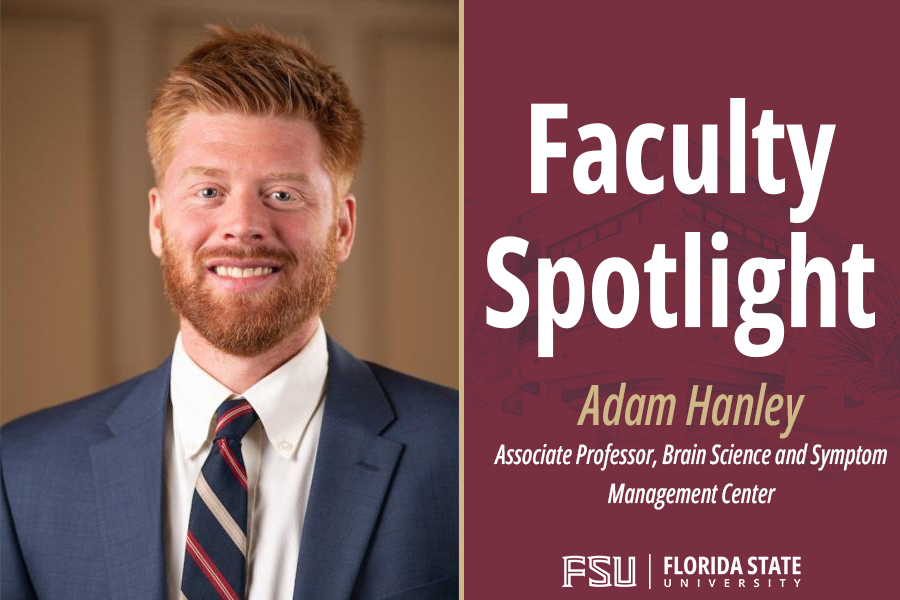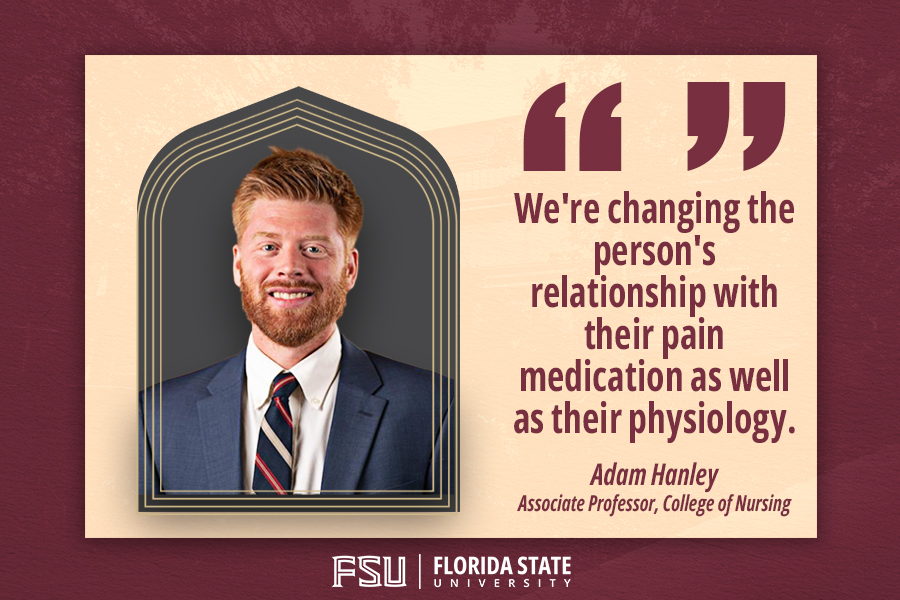
Growing up, Adam Hanley was always interested in the power of the mind. As the grandson of a preacher, he became intrigued by the combination of both spirituality and therapy as a tool for healing.
Hanley, a licensed psychologist and the director of the College of Nursing’s Complementary Health Innovation Lab, embarked on an academic journey that was inspired by the physical pain he felt when an injury ended his basketball career with Helsinki Panterrit.
“That’s when mindfulness practice became more of a central focus for me,” Hanley said about deciding to step away from basketball. “It was a way of dealing with some of the physical discomfort as well as some of the confusion about what comes next.”
Realizing he could no longer rely on his athletic skill set for his profession, Hanley enrolled in FSU’s Counseling Psychology Program and was guided by former professor and mindfulness therapy expert Dr. Eric Garland. Under Garland’s watchful tutelage, Hanley discovered that he could make a career out of teaching mindfulness practices to people struggling with chronic pain.
Hanley is part of a research team studying Mindfulness-Oriented Recovery Enhancement (MORE), a therapy that draws on neuroscience-informed techniques to ease chronic pain and addiction while also helping people find healthier pleasure and deeper meaning in life. With Dr. Garland, he has been studying MORE for 10 years, helping to optimize the eight-week treatment program. Their research shows that MORE can simultaneously decrease chronic pain and opioid use/misuse out to nine months after a patient’s treatment ends.
“We see pretty dramatic decreases in the dose of opioids that folks are taking as a result of completing the MORE treatment,” Hanley said. “We also see that mindfulness changes the way their brain reacts to pain and opioid cues.”

Participants in Hanley’s studies are hooked up to an Electroencephalogram (EEG) device that measures electrical activity in their brain. Some studies have shown that during a self-guided mindfulness practice, low-frequency brain waves known as theta waves form in the front part of their brain as the patient moves deeper into a state of meditation. This theta activity predicts less opioid use months later.
“We’re working to change the person’s relationship with their pain and reconnect them with those things that matter most,” Hanley added. “That helps them feel better physically and use less pain medication months into the future.”
To increase access to this effective treatment, Hanley has spent the last five years developing brief adaptions of MORE that can be seamlessly embedded in routine medical care.
“We’re finding creative ways to sneak a few minutes of mindfulness into clinic waiting rooms, surgical settings, cancer treatment, just about anywhere where folks are idly waiting in a health care system,” Hanley said.
The results have been startling. Patients have seen a dramatic reduction in pain through Hanley’s mindfulness techniques after just a few minutes — a 30 percent drop that is equivalent to about five milligrams of the pain killer oxycodone. Patients frequently experience emotional improvements, particularly reductions in anxiety, as they prepare for medical appointments.
Hanley recently published research on MORE’s ability to combat opioid cravings that suggests the therapy is a promising tool to fight a crisis that resulted in more than 80,000 deaths in the United States in 2024. The study shows MORE teaches mindfulness skills to regulate opioid cravings, relieve pain and recover the ability to savor natural healthy pleasure, joy and meaning in life.
The technique has proven to be a necessary alternative for patients whose health conditions do not allow them to have certain types of medications.
“Expanding their toolbox of treatments is a really gratifying thing,” Hanley said. “It’s heartening that we can offer techniques that help people feel better.”
“Expanding their toolbox of treatments is a really gratifying thing. It’s heartening that we can offer techniques that help people feel better.”
– Adam Hanley, College of Nursing
Hanley is also interested in how mindfulness helps pain patients feel better. One experience that seems to be particularly useful is “self-transcendence”, or feeling as if the sense of self were dissolving. His research indicates self-transcendent experiences are relatively common during meditation, and these altered states of consciousness allow patients to fundamentally change how they relate to their pain, which has long-term benefits.
“My shorthand for this is ‘no self, no pain,’” he said. “There’s no house or body to instantiate that pain. We’re looking to exist in this space of openness and possibility where there’s not a lot of discomfort.”
For Hanley, improving people’s quality of life is the goal. When his patients marvel at their positive results, it’s a rewarding feeling.
“Getting to hear from a patient that ‘My pain decreased’ or ‘This thing I’ve been living with for years feels manageable now’ — that’s a wonderful way for me to leave the office each day,” Hanley said.




